There is a popular tradition that James Douglas, 4th
Earl of Morton, who was the fourth Regent during the minority of the future
King James VI of Scotland (James I of England), saw the Halifax Gibbet during a
visit to the town and in 1564 had a version of his own constructed in
Edinburgh. However, Morton was only in England three times, once as a prisoner
in 1547, a second time in 1560, on a mission to the court of Queen Elizabeth,
and lastly in 1566, when he stayed for a number of years in retirement. It is
unlikely that he saw the Halifax Gibbet on the first occasion and, clearly, the
later date is after the Scottish machine was made and in use, so only the
middle date is possible.
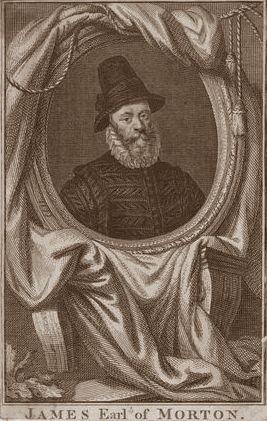 |
| James Douglas - Earl of Morton |
There is a possible reason for the confusion – Morton did
see the Halifax Gibbet, or at least heard of it, and mentioned it to a member
of the Town Council of Edinburgh. Archibald Douglas, a kinsman of Morton, was
Provost of Edinburgh, and in the Treasurer’s Accounts there is an entry for,
“The Compte of the Heding Aix maid the tyme of the comptaris office, as eftir followis, at the command of the Provost, Baillies & Counsale,”
which
places the construction of the ‘Heding Aix’ after September 29th
1564. Maybe the two Douglases have been conflated. There is another tradition,
which history proves to be false, that Morton was the first and last person to
be executed by the machine in Scotland. In fact, the first person to be so
executed was Thomas Scott, on April 3rd 1565, and although Morton
was eventually beheaded on June 2nd 1581, one account says,
‘This fatal instrument, at least the pattern thereof, the cruel Regent had brought from abroad to behead the Laird of Pennecuik.’
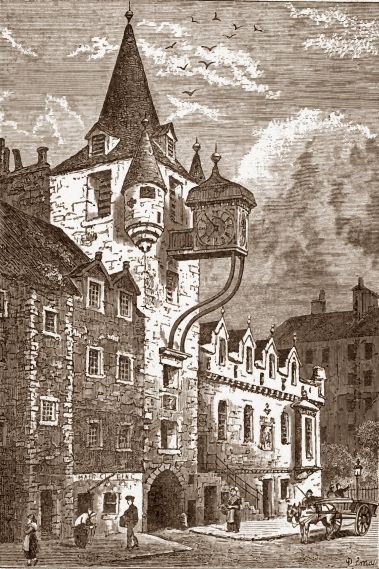 |
| The Old Tolbooth, Edinburgh |
Regardless of who had it
made, and from where they took their inspiration, it stood by the City Cross on
the Royal Mile, facing the Old Tolbooth, and was used on a regular basis. It
became known as the Scottish Maiden, some say because it stood unused for such
a long period of time (but, as we have seen, it was in use almost immediately
after completion), others say it is a corruption of the Gaelic mod-dun,
meaning ‘enclosed mound’ where ancient courts of justice were held, hence
Maiden Castle at Edinburgh, the maiden craig of Dumfriesshire, the maiden rocks
of Carrick and Fife, and the maiden stones of Ayton, Garrioch, Tullibody, and
Clackmannan.
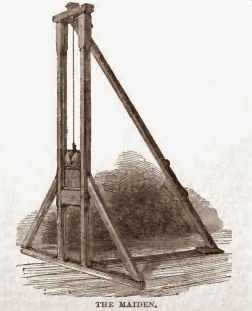 |
| The Scottish Maiden |
In the Edinburgh account books, it is variously called the Maiden,
the Miadin, the Madin or the Madyn, and, interestingly, although an early entry
records five shillings being paid to Andrew Gotterson, a smith, for ‘grynding
of the Madyn’, the same man was paid another five shillings at a later date
for ‘grynding the Widow’, hinting that the popular name of the thing
changed over the years.
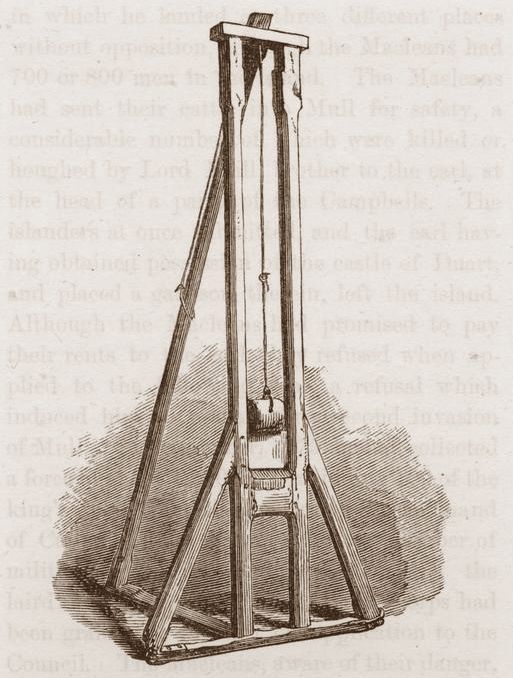 |
| The Scottish Maiden |
The Scottish Maiden is made of oak and consists of a
beam, five feet long, into which two uprights, ten feet tall and set twelve
inches apart, are fixed. A brace is hinged to the top beam and extends beyond
it, and into which a pulley is set. The blade is a horizontal iron blade, faced
with steel, weighted with seventy-five pounds of lead, and is thirteen inches long
and ten-and-a-half inches broad; it runs in copper-lined grooves in the
uprights. In use, a rope is passed through a hole in the lead on the blade and
the blade is drawn up over the pulley. An eye on the other end of the rope is
passed over a short peg, which holds it in place until the executioner presses
a longer lever on the other end of the short, restraining peg, which withdraws
and releases the blade, which descends and decapitates the prisoner.
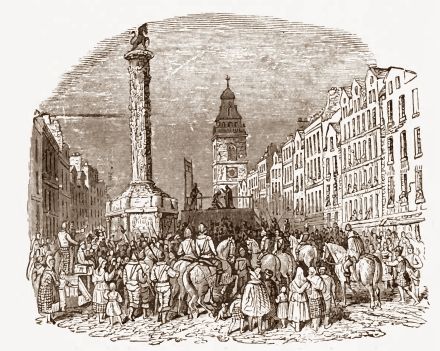 |
| The execution of the Earl of Argyle by the Maiden |
An
examination of the list of people beheaded by the Maiden reveals that high and
low, rich and poor, young and old, male and female, were all put beneath her
blade, and we know that over one hundred and twenty persons were executed over
a period of over one hundred and forty years. Its use was discontinued in 1710,
Pennant, in his Tour of Scotland of 1776, reports seeing it in a room
under the Parliament House and it now stands in the National Museum of
Scotland, Edinburgh.
No comments:
Post a Comment